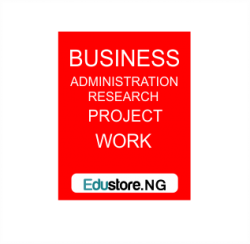Managing Staff Transition and Productivity in Private University (A Case Study of Covenant University, Otta)
Abstract
This study was on Managing Staff Transition and Productivity in Private University (a Case Study of Covenant University, Otta). Three objectives were raised which included: To examine the impact of staff technological transition on productivity in Covenant University, to determine the effect of organisation structure on productivity in Covenant University and to find out the influence of organisational leadership on productivity in Covenant University. A total of 77 responses were received and validated from the enrolled participants where all respondents were drawn from staff of Covenant University, Otta. Hypothesis was tested using Chi-Square statistical tool (SPSS).
Chapter one
Introduction
Background of the study
University education in post-independence Nigeria from 1960 to 20119 has undergone through a lot of changes characterised by rapid expansion both in terms of students’ enrolment and in sharp increase in the number of both private and public universities against a backdrop of diminishing financial support. Change is constant and it is an inevitable part of existence for individuals and organizations. In a highly competitive environment, the drive for changes in any large organisations becomes crucial for greater success and excellence. Most entrepreneurs and top executives in various organisations have been on look out toward the transitioning of staff and changing business strategies along with effective and continuous changes so as reach their potentials. In addition, nowadays, pressures for change are not merely limited from the organizational elements but also the international forces moved by the belief of globalization, technology, and competition.
There is research saying that organisational transitions mean organisation transformation (Kotter & Schlesinger, 2008). Therefore, radical changes have been prioritized as one of the most important agendas needed for discussion in a parallel relationship with other management issues. It can have effect on one small area or the entire organisation. Nevertheless, all transitions from either internal or external sources, large or small, involves adopting new mind-sets, processes, policies, practices and behaviour.
Transition is what takes us out of our comfort zone and it is inevitable (Sidikova, 2011). Kitur (2015) was of the opinion that transitions come in an organisation in different ways: merger, acquisition, joint venture, new leadership, technology implementation, organisational restructuring, and change in products or regulatory compliance. These changes are what we refer to as transition. The transition may be planned years in advance or may be sudden because of a shift in the environment. Organisational change can be radical and alter the way an organisation operates, or it may be incremental and slowly change the way things are done. In fact, trying to separate managers from leadership in the area of style is cumbersome because every manager needs to possess leadership skills to get things done and every leader must possess managerial skills to aid workers to change directions. This is especially essential in organisations or institutions that are experiencing transition since constant motivation and guidelines are needed for effectiveness of employee productivity (McLagan, 2002).
Most African countries have undergone series of changes. Universities in Africa have gone through tremendous transitional periods due to growth and expansion of institutions of higher learning. In a bid to compete globally, universities have embraced change management factors such as technology, leadership and structure which affect both employee and organisational productivity. In an attempt to remain competitive, most private universities in Nigeria particularly, Covenant University have adopted cultural systems known to every employee which are added values to their productivity, for instance we value quality education. Leadership changes may influence staff productivity. The leader as a person in charge or as a change agent can manage an organisation or the process of organisational change more effectively and successfully if he/she is capable and competent (Asghar, 2010). He noted that rapid technological advancements, high expectations of customers, and ever changing market situations have compelled organisations to incessantly reassess and re-evaluate how they work and to understand, adopt and implement changes in their business model in response of changing trends. Organisational change is a demand of the day, and needed for universities to survive. On the other hand, organisational structure changes are thought to influence employees’ productivity. This study conceptualized that managing staff transition and productivity in private university by using Covenant University, Ota as a case study.
Statement of the Problem
Employee productivity has been on the high increase as a result of improvement and adoption of transition in management by most organisations. This is because the change in management influences greatly on employees and therefore if proper change is adopted and implemented, it results in increased productivity of employees. This is in line with Sidikova (2011) that in every change proposal, there are always forces for change and forces against change. Kute and Upadhyay (2014) and Abbas, Muzaffar, Mahmood, Ramzan and Rizvi (2014) found a positive relationship on change management factors and employee productivity. There are different types of management or staff transition in every organisation. Staff or management transition may be technological staff transition, role transition and the likes, depending on the motive of the organisation. Dauda and Akingbade (2014) found no significant correlation between technological changes and employee performance. Al-Jaradat, Nagresh, Al-Shegran and Jadellah (2013) found a positive relationship between the areas of change (organisational structure, technology, individuals) and the performance of workers. Due to dynamic changes worldwide, universities as well tend to change over time in order to fit the current situation and at the same time maintain and retain customers. While industrial change is an experience that is constant, knowledge and awareness about many of the critical issues involved in the management of such transition is often lacking in those responsible for its progress (Kamugisha, 2013).
Covenant University has gone through a process of transition from a university offering first degree to a doctoral degree offering university. As a result, these transitions were based upon areas like leadership, structure and technology perspectives. This study seeks to investigate how transitions of staff in the areas like organisational structure, leadership changes and technological transitions (changes) have affected the productivity of staff in a university. It is on this basis therefore that the study seeks to investigate staff transition management and productivity in private university by using Covenant University, Otta, Ogun State as a case study.
Research Objectives
The general objective of this study is to investigate staff transition management and productivity in private university by using Covenant University, Otta, Ogun State as a case study. The specific objectives are:
- i) To examine the impact of staff technological transition on productivity in Covenant University.
- ii) To determine the effect of organisation structure on productivity in Covenant University.
iii) To find out the influence of organisational leadership on productivity in Covenant University.
Research Questions
The following are some of the questions which this study intends to answer:
- i) What is the impact of staff technological transition on productivity in Covenant University?
- ii) What is the effect of organisation structure on productivity in Covenant University?
iii) What is the influence of organisational leadership on productivity in Covenant University?
Research Hypotheses
The following will be the research hypotheses to be tested for this study:
- i) There is a significant relationship between staff technological transition and productivity.
- ii) There is a significant relationship between organisational leadership and productivity.
Significance of the Study
The study will be beneficial to government, stakeholders, educationists, school management as it will reveal how proper employee management will increase the productivity of their institutions and give them their desired results. It will also help the employees to know what is required of them at work. Also, it will contribute to the body of knowledge and help to fill all the loopholes in topics related to this. It will as help students and other researchers by serving as body of knowledge upon which other research can be made.
Scope of the Study
The study assesses the management of staff transition management and productivity in private university by using Covenant University, Otta, Ogun State as a case study. Therefore, the research will be carried out among the staff Covenant University, Ogun State, Nigeria.
Limitations of the Study
Financial constraint- Insufficient fund tends to impede the efficiency of the researcher in sourcing for the relevant materials, literature or information and in the process of data collection (internet, questionnaire and interview).
Time constraint– The researcher will simultaneously engage in this study with other academic work. This consequently will cut down on the time devoted for the research work.
Definition of Terms
The following terms were used in the course of this study
Employee: An individual who works part-time or full-time under a contract of employment, whether oral or written, express or implied, and has recognized rights and duties. Also called worker.
Productivity: A measure of the efficiency of a person, machine, factory, system, etc., in converting inputs into useful outputs. Productivity is computed by dividing average output per period by the total costs incurred or resources (capital, energy, material, personnel) consumed in that period. Productivity is a critical determinant of cost efficiency.
University: an institution of higher education and research which awards academic degrees in various academic disciplines. Universities typically provide undergraduate education and postgraduate education.
References
- Ekowo, M., & Palmer, I. (2016). The promise and peril of predictive analytics in university: A landscape analysis. New America.
- Green, H. Y. (2015). Dropout and completion in university in Europe. Publications Office of the European Union.
- Linda S. L., & To, W. M. (2010). Importance-performance analysis for public management decision making: An empirical study of China’s special administrative region. Management Decision 48, 277-295.
- Nwokocha, J., & Akande H. (2020). Rebuilding Trust in Educational Management for Effective University Education in Nigeria. World Journal Interactive Research, 2(1), 161-170. OECD (2012). Fostering quality teaching in university: Policies and practices. OECD.
- Okebukola, P. A. (2013). An African perspective on rankings in university. Rankings and Accountability in University.
- Okorie, N. C. (2009). Organizational setting of managership: Theory into practice in Universityal Organisations. Giebon & Sons Press.
- For Reference Only: Materials are for research, citation, and idea generation purposes and not for submission as your original final year project work.
- Avoid Plagiarism: Do not copy or submit this content as your own project. Doing so may result in academic consequences.
- Use as a Framework: This complete project research material should guide the development of your own final year project work.
- Academic Access: This platform is designed to reduce the stress of visiting school libraries by providing easy access to research materials.
- Institutional Support: Tertiary institutions encourage the review of previous academic works such as journals and theses.
- Open Education: The site is maintained through paid subscriptions to continue offering open access educational resources.






